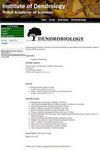Niche modelling suggests low feasibility of assisted gene flow for a Neogene relict tree, Castanea sativa Mill.
IF 1.8
4区 农林科学
Q2 FORESTRY
引用次数: 0
Abstract
Abstract: As many tree species populations are being degraded by climate change, adaptive conservation, and forest management, such as assisted gene flow (AGF), can provide the genetic variation needed to adapt to climate change. The core of this strategy is to assist the adaptation process in populations at risk of climate maladaptation by introducing individuals with beneficial alleles to cope with expected climate changes. Castanea sativa Mill. (sweet chestnut) is an essential component of natural forests in the Mediterranean and Caucasian regions, with a long history of cultivation. Current climate change may seriously threaten the long-term persistence of the species, particularly in the Caucasus region, where the largest range reductions are predicted. Here, we used Species Distribution Models (SDMs) to assess the feasibility of AGF in European and Caucasian populations of Castanea sativa. Bioclimatic variables for present (1981–2010) and future (2071–2100) conditions were obtained from the CHELSA climate database. The final models of future species ranges were averaged across three climate models (IPSL-CM6A-LR, MPIESM1-2-HR and UKESM1-0-L) and three climate change scenarios – SSP1-2.6, SSP3-7.0 and SSP5-8.5. There are marked differences in the climatic niches of the Iberian, Alpine-Apennine, Balkan, and Caucasian populations, with significant implications for AGF. The most suitable European areas for the Caucasian populations were found only in the Adriatic region. The Iberian populations were not compatible with the predicted future climate in the Caucasus in any of the scenarios tested. Suitable areas for Alpine-Apennine populations within the AGF strategy were predicted in the Colchic lowlands, the eastern Pontic mountains and the Hyrcanian forests in the SSP1-2.6 and SSP3-7.0 climate change scenarios. In contrast, the Balkan populations would be compatible at most with the western Pontic mountains and, to a lesser extent, with the Hyrcanian forests. According to the most damaging climate scenario SSP5-8.5, the potential of AGF in the Caucasus with Alpine-Apennine and Balkan populations could be very limited. Our study showed limited applicability of AGF for Castanea sativa between the European and Caucasian populations due to low climate match. Genomic modelling is needed to fully assess the feasibility of this strategy in the species.生态位模型表明,新近系残树蓖麻(Castanea sativa Mill)辅助基因流动的可行性较低。
摘要/ Abstract摘要:由于气候变化导致许多树种种群退化,适应性保护和森林管理,如辅助基因流(AGF),可以提供适应气候变化所需的遗传变异。该战略的核心是通过引入具有有益等位基因的个体来应对预期的气候变化,帮助面临气候不适应风险的人群进行适应进程。蓖麻(甜栗子)是地中海和高加索地区天然森林的重要组成部分,具有悠久的种植历史。目前的气候变化可能严重威胁到该物种的长期存在,特别是在高加索地区,预计该地区的范围将减少最多。本研究采用物种分布模型(SDMs)对番栗在欧洲和高加索居群中进行AGF的可行性进行了评价。当前(1981-2010)和未来(2071-2100)条件的生物气候变量来自CHELSA气候数据库。在3种气候模式(IPSL-CM6A-LR、MPIESM1-2-HR和UKESM1-0-L)和3种气候变化情景(SSP1-2.6、SSP3-7.0和SSP5-8.5)下对未来物种范围的最终模型进行了平均。伊比利亚人、阿尔卑斯-亚平宁人、巴尔干人和高加索人的气候生态位存在显著差异,这对AGF具有重要影响。最适合高加索人居住的欧洲地区只在亚得里亚海地区。伊比利亚人口在测试的任何情景中都与预测的高加索未来气候不相容。在SSP1-2.6和SSP3-7.0气候变化情景下,预测了Colchic低地、东Pontic山脉和hycanian森林在AGF战略范围内的适宜种群分布。相比之下,巴尔干人口最多能与西部的本蒂克山脉相适应,在较小程度上与赫卡尼亚森林相适应。根据最具破坏性的气候情景SSP5-8.5,高山-亚平宁和巴尔干人口分布的高加索地区的AGF潜力可能非常有限。我们的研究表明,由于气候匹配度低,欧洲和高加索人群对蓖麻的AGF适用性有限。需要基因组模型来充分评估该策略在该物种中的可行性。
本文章由计算机程序翻译,如有差异,请以英文原文为准。
求助全文
约1分钟内获得全文
求助全文
来源期刊

Dendrobiology
农林科学-林学
CiteScore
2.20
自引率
11.10%
发文量
17
审稿时长
>12 weeks
期刊介绍:
Dendrobiology publishes original research articles and review articles related to the biology of trees and shrubs.
 求助内容:
求助内容: 应助结果提醒方式:
应助结果提醒方式:


